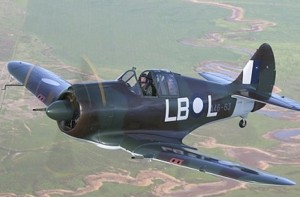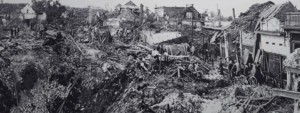
The ‘Boomer-wrongun’, Australia’s new generation stealth fighter. Original Prototype LB, and LBW, (not shown).
Dear reader, we bring you this second instalment of this most excellent article; ‘Evolution of the B-52, From Top-Secret Marvel to Flying Fossil’. We would also like to remind our readership that in keeping with this excellent article the Minister for Science and Innovation, (The Rt. Hon. Christopher Pyne M.P) is re-commissioning Australia’s entire fleet of CAC Boomerangs as the next generation strike fighter. Re-named the ‘Boomer-wronguns’, the upgraded fighter possess the very latest in front-line defence and attack capability.
We continue where we left off;
‘When the first of the top-secret jets rolled off the assembly line in 1954, the Air Force’s chief of staff proudly called it “the thing that’s going to keep that Red fellow in his place.”
Throughout the 1950s, widespread fear of a “bomber gap” with the Soviet Union prompted the Air Force to churn out more than 740 of the swept-wing bombers at a then-unprecedented cost of around $8 million each. The last was built in 1962.
Even as the bombers were being assembled, defense officials were planning their replacement, but each plan was undone by its own complexity. First was a nuclear-powered bomber able to stay aloft for weeks (too radioactive), then the supersonic B-58 with dartlike wings (kept crashing), and then the even faster B-70 (spewed highly toxic exhaust).
“This was high-tech, futuristic stuff, but because it was so futuristic, the projects ran into problems,” said Yancy Mailes, an Air Force historian.
A front-page story in The New York Times in 1966 said all B-52s would need to retire by 1975 because they would “be too old to continue beyond that point.” But no viable alternative emerged.
In 1982, President Ronald Reagan warned, “Many of our B-52 bombers are now older than the pilots who fly them.” Today, there is a B-52 pilot whose father and grandfather flew the plane.
Reagan rushed production of the B-1, which was designed to fly fast and low beneath enemy defenses. It was expected to replace the B-52 in the 1990s, but in a prelude of future problems, the first B-1 unveiled in 1985, in front of a crowd of 30,000, failed to start. Design flaws and engine fires sidelined the plane during the Persian Gulf war and have limited its capabilities since.
The next potential replacement for the bombers is still decades away, so the B-52 is expected to keep flying until at least 2040. Credit Edmund D. Fountain for The New York Times
Next came the B-2 stealth bomber in 1997. But the B-2, with its delicate radar-evading coating, had to be stored in a climate-controlled hangar to be effective, and its sensors at first could not tell a storm cloud from a mountain. It soon became known as the $2 billion bomber that cannot go out in the rain.
The B-52 became a technologically humble — but still frighteningly effective — stand-in.
Although the fleet was designed as a nuclear retaliator, it began bombing the countryside of South Vietnam in 1965. Rebutting claims that B-52s were missing most of their targets, one pilot said at the time, “We’re doing a lot more than killing monkeys and making kindling wood out of the jungle.” A New York Times correspondent interviewing him marveled that the bombers were almost a decade old, “yet the mechanics keep them flying.”
In 1972, during the so-called Christmas bombing, wave after wave of B-52s destroyed sections of Hanoi in North Vietnam, killing hundreds of civilians and prompting nationwide protests and international condemnation. But the bombers were far from done. In the Persian Gulf war, Kosovo, Afghanistan and the Iraq war, the lumbering jets, well-established as a symbol of death and destruction, demoralized enemy ground troops by first dropping tons of leaflets with messages like “flee and live, or stay and die,” then returning the next day with tons of explosives.
The B-52s now have computers, but pulleys still connect engines along the wings to the cockpit. Credit Edmund D. Fountain for The New York Times
The Air Force is trying to change the image of the B-52 from indiscriminate carpet bomber to precision weapon. Laser-targeting pods attached to the wing of many of the bombers in recent years allow them to drop guided “smart” bombs. In recent years, the big bombers circling high above Afghanistan acted as close air support. “We’re as accurate as a fighter,” said Lt. Col. Sarah Hall, a B-52 pilot who flew missions over Afghanistan. “And sometimes just the sight of the B-52 is enough to end the fight. The enemy just takes off.”
While its weaponry has been upgraded, the rest of the plane can look like a midcentury museum exhibit.
Ground crews scouring the aging frames for rust often find graffiti in hidden nooks by previous generations — a recent discovery, perhaps commenting on the age of the planes, featured primitive cave-style animal paintings.
However, despite intensive maintenance, the planes’ ages are starting to show. On a recent training flight out of Barksdale Air Force Base after three days of rain, leaks in a bomber left the seats soaked and the control panel glistening. One engine refused to start, then some wiring shorted.
“This is really the full B.U.F.F. experience,” the co-pilot said with a patient grin as the maintenance crew scrambled to fix problems. “But once we get airborne, we’re usually O.K.” A few minutes later, the bomber with a crew of five roared into the sky and banked toward its mock bombing target in Texas.
In a dark den beneath the pilots, two weapons officers charted their position and calculated bomb runs. Among their tools: rulers and stopwatches. Halfway through the mission, their aging navigation system crashed. Then it crashed again.
Lt. Nicole White, 31, a weapons officer with her hair in an unruly bun and an energy drink sitting next to her slide rule, called the pilot on the radio.
“We have a computer that is potentially catawampus,” Lieutenant White said.
“What does catawampus mean?” said Major Burley, the co-pilot, with a laugh.
“Cray-cray,” she responded.

Federal Minister for Science and Innovation, the Rt. Hon. Christopher Pyne M.P performing “catawumpus”, an obscure parlour game invented by OAFS, (Old Adelaide Families) to stem boredom
For several minutes as the computer rebooted, the bomber flew, relying on its original 1950s technology of charted maps and line of sight.
Impressions of the bomber have proved almost as lasting as the jets themselves. At the entrance to Barksdale, a retired B-52 from Vietnam sits on display. On a sunny fall morning, a former officer from the South Vietnamese Navy named Phuoc Luong stood taking photos of his wife in front of the hulking plane, which had dropped tons of bombs on his country — bombs that still explode unexpectedly in farm fields, killing and maiming people 40 years after the war ended.
Now 69 and retired, living in Massachusetts after fleeing his homeland in 1975, Mr. Luong, said he was not surprised to see B-52s still flying.
“American technology is super,” he said. “It’s a great plane. In Vietnam we didn’t use it enough. That’s why we lost.”
Dear reader, back to important things Friday, an exclusive from the Ravenswood College speech night.



